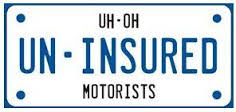Image may be NSFW.
Clik here to view. Auto accidents happen every day and no one sets out to have them (with the exception of criminals trying to defraud insurance companies, that is.) Events also happen that cause damage to a vehicle that’s not due to an accident.
Auto accidents happen every day and no one sets out to have them (with the exception of criminals trying to defraud insurance companies, that is.) Events also happen that cause damage to a vehicle that’s not due to an accident.
Some people don’t realize that different types of claims score against your policy differently. There are some claims that are called in when the owner wasn’t even in or near the car. For example: A tree falls on the car or other type of falling debris, a pedestrian (or maybe an ex-girlfriend?) scrapes the side of the car with their keys, a hail storm causes dents, a hit and run driver hits your car in the middle of the night, etc.
When any of these situations occur, the first thought of a car owner is usually to call the insurance company and make a claim. The average car owner doesn’t care what kind of coverage is going to protect the car and allow it to be fixed—usually they just want it fixed. But before you do so, put your place in the insurance company’s place—they’ll want to recoup the money they pay for your loss, and they’ll get that by charging you higher premiums.
When learning about auto insurance, you may have heard that your premiums will never rise if an accident is from a comprehensive claim or UMPD. However, there are times both types of coverage will cost you—whether now, or in the long run.
UMPD
If someone hits a car, runs off, and the owner has no idea who has hit it, things can be tricky. If you choose this coverage when you set up your policy, this will take care of hit and run incidents as long as it has been followed up with a police report. This will usually have a small deductible, anywhere from $100 to $500, but the average is around $250 according to the Insurance Information Institute (III).
If you don’t have collision coverage on your car and someone commits a hit and run, you aren’t covered and would have to fix or replace your car. You can always pursue a police investigation if you think you can find who did it and take them to court. Otherwise, there is no coverage.
Comprehensive
Picture this. Your car is parked outside and a storm comes through. Perhaps hail hits the car or a tree is uprooted and falls on your car. This would be a comprehensive claim as comprehensive coverage pays for damage to your vehicle that results from something totally out of your control, such as hitting a deer, vandalism and theft, and acts of nature. This claim typically isn’t counted against you like an at-fault accident or collision claim would be.
Certain insurance companies sometimes phrase comprehensive as “other than collision.” However, sometimes it will count it as a “claim” but not an “accident.” This would unfortunately mean that the ‘claim,’ even if not at fault, would rate against your policy resulting in a higher premium.
Your rate could still increase because of a comprehensive claim, but it won’t increase as much as an accident would. However, if you have too many claims, even if they were out of your control, like storm damage, flood, or theft, your insurer could require you to carry a high-risk policy. Essentially, an insurer views several comprehensive claims as a signal that the driver who claimed them must be a ‘magnet’ for accidents. This varies by insurer, so you’d have to ask how your specific carrier views this.
Before you place a claim, find out what your state guidelines and regulations are and what types of coverage you have on your policy. Be proactive and find out before a claim occurs. You’ll then know better how to handle claims.
You also have to make a bit of a decision here based on simple mathematics. It will depend on your deductible, your liquid assets, and the vehicle. Assume you buy a policy with a collision deductible of $500. Then you have an accident, and it does $567 in damages. You’d be responsible for paying $500, and the insurer would only pay $67. The claim would be on your insurance record as a $567 claim, which would follow you and be rated on any insurance policy for the next five to seven years, depending on the company.
With that claim rated, other insurers would just see you had a collision claim, regardless of how small and regardless of the fact that you paid for the majority of repairs. The result would be a higher premium for years, and you’d end up paying way more than you would have if you had just paid the $567 yourself. The amount you’ll pay in future premium would be way higher than that $567. Basically, it comes down to a question—pay now or pay later? If you can’t pay your deductible, you may have to pay significantly more down the road, just one more reason to always ensure you can pay your deductible any given day.
Follow Desiree Baughman on Twitter @DesireeBaughman.